What Is Bitumen and Bitumens Types?
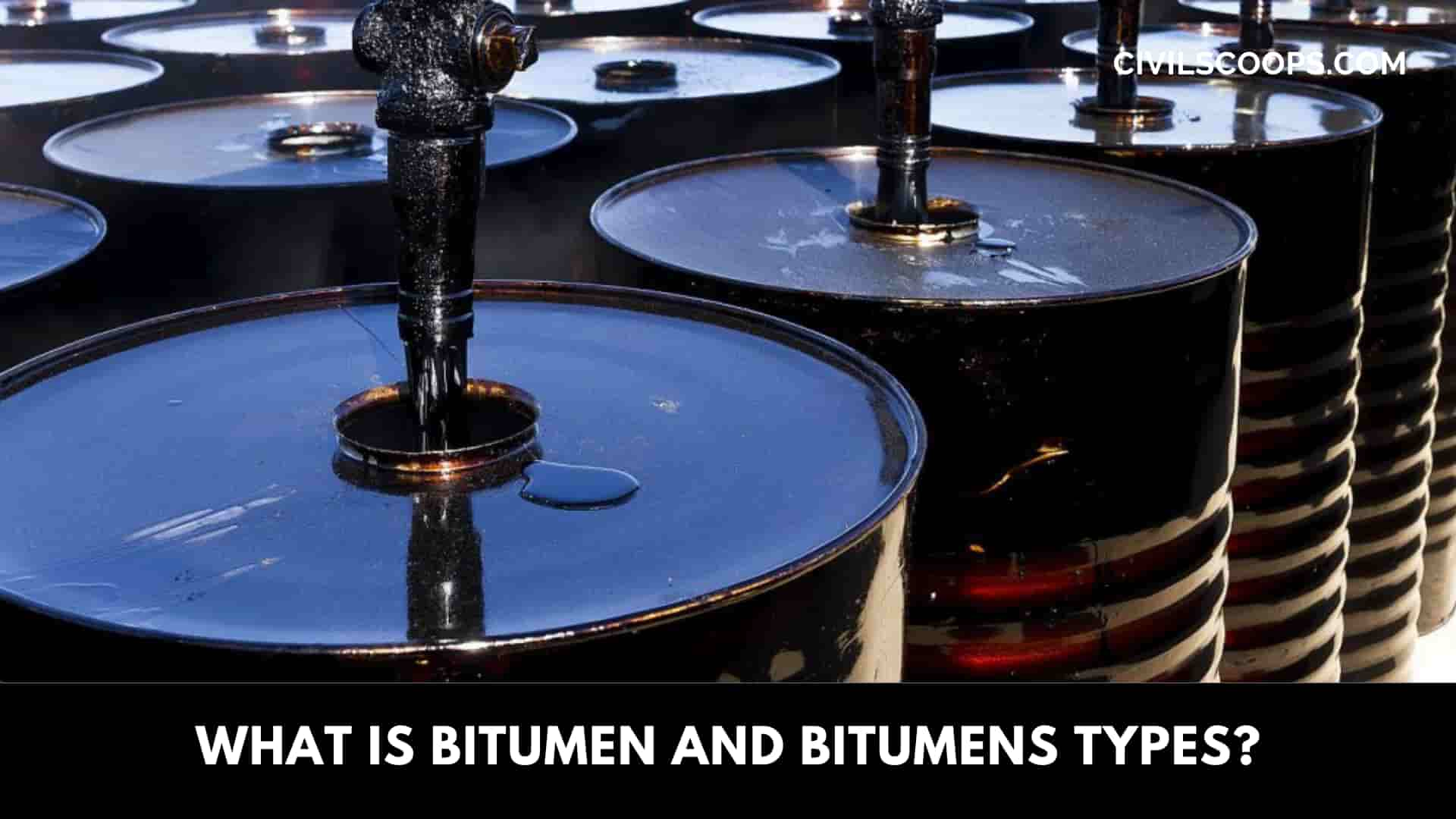
Table of Contents
What is Bitumen?

Bitumen is a viscous, solid, or nonvolatile liquid. Bitumen is a complex and complected colloid system, the chemical properties of that are determined by the properties of crude oil by which it’s produced.
Pure bitumen is a colloid dispersion of microscopic asphalt particles in oil (dispersion agent).The chemical composition of bitumen is a mixture of various hydrocarbons with molecules of sulfur, oxygen, and nitrogen.
Hydrocarbons present in bitumen are mostly condensed aromatic rings and naphthene with a small number of side paraffin chains.Mass fraction of hydrocarbons is 75-85%, oxygen 2-8%, hydrogen 9-10%, nitrogen 0.1-0.5%, and sulphur 5-7%.
Bitumen is completely or partially soluble in various organic solvents. Dissolved fractions of bitumen in a solvent are called maltenes or petrolenes, and undissolved fractions are called asphaltenes.
The maltenes are a mixture of oil and resins, and they are a dispersing agent.For the most part, the physical properties of bitumen depend on the dispersion degree of asphaltenes In maltenes.
It gradually softens as It is heated. Bitumen Is brown or black, waterproof, and it is good adhesive. Bitumen can be obtained in several ways, which depends on the economy of certain processes under the actual conditions.
The majority of bitumen is produced by treatment of an appropriate atmospheric residue in the vacuum distillation unit.
Bitumen is a residue of vacuum distillation, and its hardness depends on the composition of the heavy oil distillates.
In addition to vacuum residue, the raw materials for bitumen production can be asphalt produced by a deasphalting process, slurry oil, and extract produced by the solvent extraction process.
If asphalt, slurry oil, and extract are mixed with vacuum residue, which is obtained from a particular raw material, and then they are oxidized by air, various bitumen types are obtained.
Oxidized bitumen is less temperature sensitive than bitumen obtained by mixing of particular fractions. Oxidation of bitumen results in partial dehydrogenation of asphaltenes, which creates long chains of asphaltenes molecules by polymerization and condensation reactions.
Harder bitumen is produced by oxidation. The desired quality of hard bitumen cannot be produced from too soft raw material by oxidation.
Bitumen types depend on the volatility of oil substances in bitumen.A small amount of volatile oil substances makes bitumen harder and more brittle.
Bitumen has multiple uses (road construction, isolation mate-rial), so it is very important for bitumen to have good adhesivity, i.e., to adhere very well to stone, metal, wood, paper, and other substrates.
Adhesivity depends on chemical content, viscosity, bitumen colloid state, and chemical and physical properties of the substrate.
Thermal properties of bitumen, such as specific heat and thermal conductivity, are important in the manufacturing of insulating materials.
Bitumen Types:
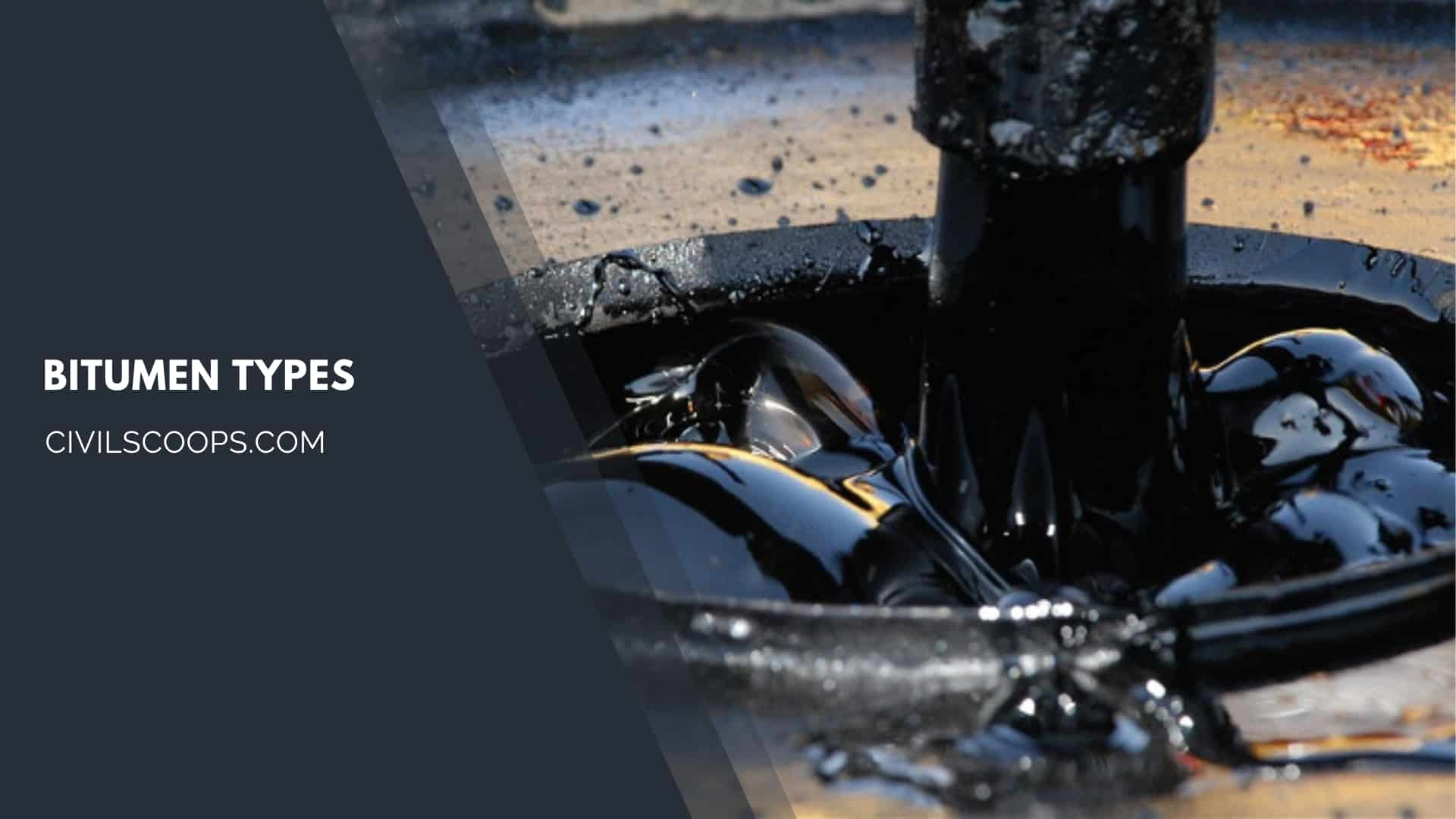
- Road Construction Bitumen
- Industrial Bitumen
- Polymer Modified Bitumen
- Bitumen Emulsion
- Other types of Bitumen
- Penetration Grade Bitumen
- Oxidized Bitumen Grades
- Cut Back Bitumen
1. Road Construction Bitumen

Road construction bitumen is used for the construction of roads and highways.
There are many types of road construction bitumen, which are determined by penetration point and softening point.
Types of road construction bitumen with their basic properties are shown below the table.
[su_table responsive=”yes” alternate=”no”]
| Properties | 20/30 | 30/45 | 35/50 | 50/70 | 70/100 | 100/150 | 160/220 |
| Penetration (0.1 mm) | 20-30 | 30-45 | 35-50 | 50-70 | 70-100 | 100-150 | 160-220 |
| Ring & Ball | 55-63 | 52-60 | 50-58 | 46-54 | 43-51 | 39-47 | 30-38 |
| Breaking point (oC) | – | -5 | -5 | -8 | -10 | -12 | -15 |
| Viscosity (mm2/s) | 530 | 400 | 370 | 295 | 230 | 175 | 135 |
| Flashpoint (oC) | 240 | 240 | 240 | 230 | 230 | 230 | 220 |
[/su_table]
Specifications of road construction bitumen
It is evident that softer road construction bitumen’s 100/150 and 160/200 have lower softening points, lower breaking points, and lower viscosity.
In the production of the road construction bitumen, a fraction of the vacuum residue has to be at least 60%, and a fraction of the asphalt and extract can be the most up to 20%.
Road construction bitumen 160/220 is the only bitumen that can be produced without the oxidation.
All the other road construction bitumen from 20/30 to 100/150 can be produced only by oxidation.
The most suitable crude oils for bitumen production are crude oils of naphthene and mixed base.
Bitumen of desired quality cannot be produced from paraffin crude oil of Libyan, Algerian, and Azeri type. Bitumen of the best quality is produced from the crude oil of Boscan, Bachaquero, Lagotreco, and Lagunillas (Venezuela) type.
Vacuum residue yield, i.e., bitumen from these crude oils, is 27-61% w/w. In addition to these crude oils, high-quality bitumen is also produced from the Middle East crude oils (Arabian light, Iraq, and Kuwait).
2. Industrial Bitumen

Industrial Bitumen 80/100
Industrial bitumens are produced from the vacuum residue with the addition of oil components by the oxidation process, i.e., air blowing.
In the production of industrial bitumen, there has to be 60-70% w/w of bitumen and 30.40% of oil components in the mixture. Oil components are added in order to achieve a certain high penetration point.
The application of bitumen in the industry is multiple and versatile. It is used because it is water-resistant, durable, and resistant to chemical reactions.
Industrial bitumen is used in construction for insulation, making of roof cardboards, impregnation, internal plumbing protection, external plumbing protection, waterproof papers production, and they are also used in electro-industry, rubber industry, for making of protection coats, sealing masses, etc.
Types of industrial bitumen with their basic properties are shown below the table.
[su_table responsive=”yes” alternate=”no”]
| Properties | 75/30 | 85/25 | 85/40 | 95/30 | 100/25 | 115/15 | 125/30 |
| Penetration (0.1 mm) | 25-35 | 20-30 | 35-45 | 25-35 | 20-35 | 10-20 | 20-35 |
| Ring & Ball | 70-80 | 80-90 | 80-90 | 90-100 | 100-110 | 100-110 | 120-130 |
| Breaking point (oC) | -12 | -10 | -20 | -15 | -15 | -10 | -20 |
| Flash point (oC) | 230 | 240 | 240 | 240 | 240 | 250 | 260 |
[/su_table]
Types and properties of industrial bitumen
It is clear that industrial bitumens are hard (low penetration point), have high softening points, and low breaking points, which are all good properties with respect to their application.
3. Polymer Modified Bitumen
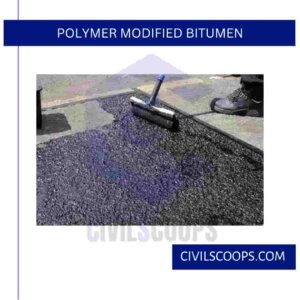
Polymer Modified Bitumen
In the case of the road construction and industrial bitumen, it is clear that the worst properties are: softening at higher temperatures, poor mechanical and elastic characteristics.
In order to improve the resistance to mechanical impact, increase cohesion, improve break-ing resistance, and improve elasticity, it is necessary to add certain polymers to bitumen.
Polymers should not significantly improve the viscosity of the bitumen mixture. Chemical compatibility of bitumen and polymers has to be satisfactory so that the separation of phases does not happen.
The best and most used polymer is styrene-butadiene-styrene (SBS).SBS polymer is thermoplastic polymer based on styrene and butadiene and their polymerization insolvent, which is characterized by block structure, which has a radial or linear arrangement with polybutadiene phase in the middle and polystyrene block at the ends.
The radial shape has a more compact molecule than linear shape, which ensures its much higher molecular weight without breaking the limiting value of viscosity.
Almost all polymer/bitumen mixtures are two-phase systems.Polymer density is always lower than bitumen density, so the polymer phase is on the top, and the bitumen phase is on the bottom.
The chemical composition of bitumen plays an important role in the production of polymeric bitumen.Lack of aromatic compounds in bitumen (vacuum residue from paraffin crude oil) is the reason why permanently homogenous mixtures with SBS cannot often be obtained, or colloid structure of bitumen is disturbed.
The blending of the relatively small amount of SBS into bitumen results in an increase of the working range with bitumen and its elasticity.
For the existence of the stable homogenous mixture of bitumen and polymer combination of components is very important.Polymer blend-ing with bitumen slows down the bitumen aging process.
Since aging is mostly an oxidation process, polymers with double bonds react with oxygen.They are the inhibitors of oxidation of bitumen components because they protect sensible bitumen components from oxidation.
The stability of the polymer and bitumen mixture also depends on asphaltene content.To have a stable colloid bitumen structure, asphaltenes need to swell in the solution of aromatic and naphthene-aromatic hydrocarbons.
If bitumen contains a small amount of aromatic in a bitumen-polymer mixture, three phases can form asphaltene precipitate at the bottom, bitumen without asphaltene in the middle, and polymers particles on the top.
Therefore, an aromatic component of extract or heavy cyclic oil type is added during the polymeric bitumen production, which will enable the stability and homogeneity of the mixture.
This is particularly important in storing the polymeric bitumen because phase separation can happen due to instability.Polymeric bitumen cannot be stored or transported for a long period of time because of this.
There are four methods of polymeric bitumen production:
- A direct blending of polymers with bitumen
- Blending of previously swollen polymers with bitumen
- Addition of monomers to bitumen and polymerization in bitumen
- Addition of multipurpose polymers based additives to bitumen so they would blend more easily.
The most often used method is a direct polymer and bitumen blend-ing inside the mixing tank.
In road construction bitumen, the requests for roads which are under heavy load are:
- Improved flexibility at low temperatures
- Improved resistance to permanent deformation
- Improved resistance to cracking due to fatigue of material
- Improved wear-resistance
- Improved age resistance
All these requirements are solved with polymeric bitumen. Polymeric bitumen can be produced in the refineries (fixed unit) or on building sites (mobile unit).
A fraction of styrene-butadiene-styrene polymer in polymeric road constructing bitumen is 3-15% w/w.The temperature of polymeric bitumen blending is 180-200 °C.
Too high temperature has a negative influence because the produced mixture can become brittle after the bitumen hardness and because of oxidation degradation of polymers.Polymer dispersion has a huge influence on thermal conditions.
4. Bitumen Emulsion
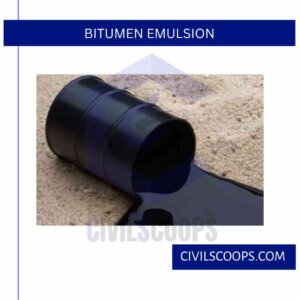
Bitumen Emulsion
Bitumen emulsion is the mixture of bitumen (50-70%), water, and 0.5% 1.0% emulsion agent, which is the most often a soap.
Bitumen emulsions are used cold during the road construction and for industrial purposes.Emulsions that are used for road construction are made from bitumen, which has penetration point 200-300.
Emulsions have to be stable inside the storage and during transportation, and they also have to have defined viscosity in order to prevent bursting.
Road construction bitumen emulsions contain about 70% of binding matter, and they burst at 80 °C.Industrial emulsions, in addition to bitumen, also contain various clay mixtures.
Industrial bitumen emulsions are used for making roof and floor insulation, and also used in the paper industry.
Bitumen with penetration point 40-50 is used for roof and floor insulations, while very hard bitumen with a very high softening point is used in the paper industry.
5. Penetration Grade Bitumen

Penetration grade bitumens are specified by the penetration and softening point tests.The designation is by penetration range only, example, 40/60 pen bitumen has a penetration that ranges from 40 to 60 inclusive and a softening point of 480C to 560C.
The unit of penetration is given as a decimillimeter (dmm). This is the unit that is measured in the penetration test notwithstanding, penetration grade bitumens are usually referred to without stating units.It is summarised here as per the below table.
[su_table responsive=”yes” alternate=”no”]
| Property | Unit | Test Method | 250/330 | 160/200 | 100/150 | 70/100 | 50/70 | 40/60 | 35/50 | 30/45 | 20/30 |
| Penetration at 25 oC | 0.1mm | EN 1426 | 250-330 | 160-220 | 100-150 | 70-100 | 50-70 | 40-60 | 35-50 | 30-45 | 20-30 |
| Softening Point | oC | EN 1427 | 30-38 | 35-43 | 39-47 | 43-51 | 46-54 | 48-56 | 50-58 | 52-60 | 55-63 |
| Change of Mass Maximum | % | – | 1 | 1 | 0.8 | 0.8 | 0.5 | 0.5 | 0.5 | 0.5 | 0.5 |
| Retained Penetration Minimum | % | – | 35 | 37 | 43 | 46 | 50 | 50 | 53 | 53 | 55 |
| Softening Point after Hardening Minimum | oC | EN 1427 | 32 | 37 | 41 | 45 | 48 | 49 | 52 | 54 | 57 |
| Flash Point Minimum | oC | EN22592 | 220 | 220 | 230 | 230 | 230 | 230 | 240 | 240 | 240 |
| Solubility Minimum | % (m/m) | EN 12592 | 99 | 99 | 99 | 99 | 99 | 99 | 99 | 99 | 99 |
[/su_table]
Specifications for paving grade bitumens with penetrations from 20 to 330 dmm
It refers to a number of European Standards that are relevant to the performance of paving grade bitumens.The majority of penetration grade bitumens produced are used in road construction.
The tendency over the last decade of the twentieth century was to adopt harder bitumens that produce asphalts which have superior properties to those that are manufactured using the softer grades.
6. Oxidized Bitumen Grades
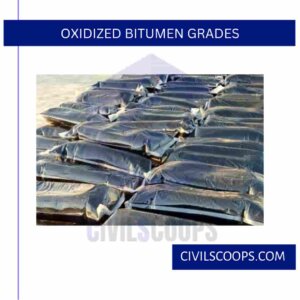
Oxidized Bitumen 85/25
Oxidized bitumens are used almost entirely for industrial applications, e.g., roofing, flooring, mastics, pipe coatings, paints, etc.
They are specified and designated by reference to both softening point and penetration tests, e.g., 85/40 is an oxidized grade bitumen with a softening point of 85 ± 50C and a penetration of 40 ± 5 dmm.
Oxidized bitumens also have to comply with solubility and loss on heating criteria.The specification requirements for the six oxidized grade bitumens specified in the UK, reproduced here as below table.
[su_table responsive=”yes” alternate=”no”]
| Properties | Test Method | 75/30 | 85/25 | 85/40 | 95/25 | 105/35 | 115/15 |
| Softening point oC | BS 2000: Part 58 | 75 ±5 | 85±5 | 85±5 | 95±5 | 105±5 | 115±5 |
| Penetration at 25 oC, DMM | BS 2000: Part 49 | 30 ±5 | 25±5 | 40±5 | 25±5 | 35±5 | 15±5 |
| Loss on heating for 5 h at 163 loss by mass %, max oC | BS 2000: Part 45 | 0.2 | 0.2 | 0.5 | 0.2 | 0.5 | 0.2 |
| Solubility in trichloroethylene % by mass, min | BS 2000: Part 47 | 99.5 | 99.5 | 99.5 | 99.5 | 99.5 | 99.5 |
[/su_table]
Specification for oxidized bitumens
The softening points of oxidized grades of bitumen are much higher than those of the corresponding penetration grade bitumen and therefore
Also Read: All About Mix Design of Concrete | What Is Mix Design of Concrete | Nominal Mix | Design Mix
7. Cut Back Bitumen

Cutback bitumens are manufactured by blending either 70/100 pen or 160/220 pen bitumen with kerosene to comply with a viscosity specification.
In the UK, cutback bitumens are specified and designated by the flow time (in seconds) through a standard tar viscometerThree grades are available: 50 sec, 100 sec and 200 sec.
The majority of cutback bitumen is used in surface dressing but a significant amount is also used for the manufacture of both standard and deferred set asphalt.
In addition to STV tests and solubility, cutback bitumens have to comply with a distillation specification and a penetration requirement on the residual bitumen.
This ensures that during application and in service, the diluent will evaporate at a consistent and predictable rate and that the residual bitumen will have the appropriate properties in service.
The suffix on the SHELPHALT range of cutback bitumens indicates that they have been doped with a specially formulated heat-stable passive adhesion agent.
This additive assists the wetting of the aggregate and resists stripping of the binder from the aggregate in the presence of water.
[su_box title=”FAQ” style=”default” box_color=”#333333″ title_color=”#FFFFFF” radius=”3″ class=”” id=””]
What Is Bitumen Used for?
Bitumen (sometimes referred to as asphalt or tar) is a specialist fuel grade that can be used in applications such as road surfacing, roofing and certain types of paint. It is a unique form of petroleum that we could not live without.
What Is Bituminous?
Of, Containing, or of the Nature of Bitumen.
What Is Bitumen Made of?
Bitumen is a byproduct of crude oil. it is composed of complex hydrocarbons and contains elements like calcium, iron, sulfur, and oxygen. The quality of material and ease of production depends on the source and type of crude oil from which it is derived.
What Is Cutback Bitumen?
Bitumen is ‘cutback’ by adding controlled amounts of petroleum distillates such as kerosene. This is done to reduce the viscosity of the bitumen temporarily so it can penetrate pavements more effectively or to allow spraying at temperatures that are too cold for successful sprayed sealing with neat bitumen.
What Is Bituminous Material?
Bituminous materials are dark brown or black, semi-solid or liquid, thermoplastic mixtures of hydrocarbons derived from natural or synthetic processes in which hydrocarbon mixtures have lost their volatile components leaving a denser residue. Natural bitumens come from exposed and weathered petroleum and rock deposits.
What Is Bitumen Made from?
Bitumen is produced through the distillation of crude oil and also occurs naturally. Bitumen is known for its waterproofing and adhesive properties. It is composed of complex hydrocarbons and contains elements like calcium, iron, sulfur, and hydrogen.
What Is Bitumen Felt?
Bitumen (asphalt or coal-tar) is a mixed substance which is made up of organic liquids that are highly sticky, viscous, and waterproof, whereas ‘Felt’ is an unwoven fabric made by matting fibers under pressure.
What Are the Types of Bitumen?
Different Types of Bitumen, their Properties and Uses
- Penetration Grade Bitumen.
- Oxidized Bitumen.
- Cutback Bitumen.
- Bitumen Emulsion.
- Polymer–Modified Bitumen.
What Are the Three Types of Bitumen?
The bitumen can be classified into the following grade types: Penetration Grade Bitumen. Oxidized Bitumen Grades. Cut Back Bitumen.
What Is Bitumen in Road Construction?
While asphalt is a manmade material that is used to pave roads, bitumen is a byproduct of crude oil that is used for its waterproofing and adhesive properties. As such, it is used to bind asphalt together during road construction and in roofing applications.
What Is Bitumen Emulsion?
Bitumen emulsions are usually two-phase systems consisting of two immiscible liquids, bitumen and water. The bitumen phase can be dispersed in the aqueous phase by mechanically shearing it in a colloid mill.
What Is Bitumen Emulsion Used for?
Bitumen emulsion is a liquid composed of three liquid materials: water, bitumen and an emulsifier. It is used in the course of road works to seal roads and protect them from the elements. There are a variety of different types of bitumen emulsions which are used in the course of road works and road maintenance.
Why Is Bitumen Not Used as a Fuel?
Bitumen itself is a black and very sticky liquid. It’s also highly viscous and so full of carbon that it cannot be used for combustion (unlike gasoline, diesel and jet fuel).
[/su_box]
[su_note note_color=”#F2F2F2 ” text_color=”#333333″ radius=”3″ class=”” id=””]
Like this post? Share it with your friends!
Suggested Read –
- All About Energy-Efficient Homes
- Commercial Building Roof Types | What is Commercial Building Roof
- All About Bathroom Accessories | 28 Different Types of Bathroom Accessories
- What Is Sewage Pump | Types of Sewage Pump | Advantages and Disadvantages of Sewage Pump
- All About Roof Overhangs | 10 Various Types of Roof Overhangs | Standard Roof Overhangs | Overhang Roof Design | Roof Overhangs on Houses
[/su_note]
Originally posted 2023-04-18 07:13:21.
